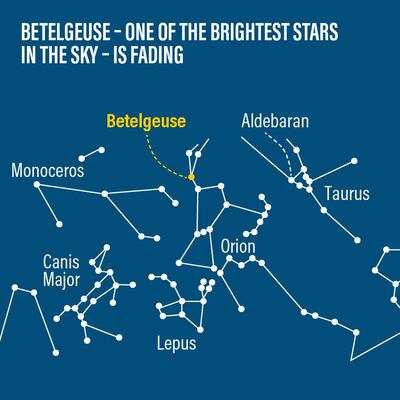One of the brightest stars in the night sky has started to fade out – and may be about to explode in a cataclysmic supernova.
Familiar to every star-gazer, Betelgeuse – pronounced “Be-tel-jooz” - is a red giant star on the eastern shoulder of the constellation Orion, currently visible in the southern night sky.
Over ten times more massive and a billion times bigger than our own sun, it’s intensely luminous and ranks among the brightest stars visible from Earth.
But over recent months Betelgeuse has started to grow fainter. Observations by astronomers show that it’s around 2.5 times dimmer than in early autumn.
While the star’s brightness has been known to vary over time, so large a decline suggests it may be running out of hydrogen, its prime fuel.

The consequences would be dramatic. Lacking the heat needed to push against the crushing pull of its own weight, fuel-starved Betelgeuse will collapse, triggering a supernova explosion more brilliant than a billion suns.
Exactly when the explosion will take place is currently being debated by astronomers. Some insist Betelgeuse will soon brighten up again. But no-one doubts it will die in a supernova. And at barely 650 light-years from Earth, it will be by far the closest supernova witnessed in recorded history.
It would also be a breath-taking sight, cramming the light of the full moon into a single point of light visible for months in broad daylight.
Fortunately, apart from potential eyesight damage from staring too long at it, the supernova is unlikely to pose a threat to life on Earth. While very close in cosmic terms, it’s far enough away to keep us safe from the effects of the radiation and debris.
As a red giant star barely 10 million years old, Betelgeuse also belongs to the “live fast, die young” class of stars which end in so-called Type II supernovas. While spewing out more radiation in a matter of days than the sun does during its entire lifetime, this is dwarfed by the effects of Type 1 supernovas, where one star destroys another in orbit around it.
But if either type took place much closer to the Earth, the radiation blast and debris would pose a major threat to the Earth. This isn’t a theoretical possibility, either. New research suggests a Betelgeuse-type supernova may have triggered a mass extinction of life around 2.6 million years ago.
The research builds on a 2017 paper in Nature which reported a bizarre discovery about this period of Earth history, known as the Pliocene-Pleistocene boundary. Studies of the fossil record had revealed that over one-third of all large marine creatures had suddenly vanished from the world's coastal waters.
Various explanations were suggested, ranging from climate change to shifts in oceanic currents.
But now another candidate is being taken seriously: a nearby supernova explosion. Until recently, astronomers had played down such a possibility on the grounds that such events are rare: perhaps just one or two per century across the entire galaxy.
As such, the chances of one occurring close to the Earth were regarded as comfortingly low.
However, there’s a loophole in this argument: stars capable of going supernova may not be evenly spread across the galaxy.
It’s a loophole with major implications for the Earth. That’s because astronomers have discovered that for the last few million years our solar system has been travelling through a region of space called the Local Bubble. And it’s rich in young red giant stars destined to go supernova.
Studies suggest 20 supernova explosions have occurred in this small part of the galaxy over the last 10 million years or so – with some just 100 light years from the Earth.
That’s close enough to have devastating effects. The principal threat comes not from the gamma radiation, X-rays and UV unleashed, but by fast-moving particles known as cosmic rays.
Arriving with the debris from the explosion, these would damage the Earth’s ozone layer, exposing both land and sea to higher levels of UV radiation from the sun. The particles may also affect photosynthesis and DNA, and trigger sudden changes in climate.
The combination could easily trigger a mass extinction of the kind that took place around 2.6 million years ago. But the question is: did a supernova actually take place around then ?
A report on near-Earth supernovas recently submitted to the US National Academies of Sciences states there is now “solid experimental evidence” of at least one supernova explosion around this period.

The evidence takes the form of traces of Fe-60, a radioactive isotope of iron, found in samples taken from the bottom of the Pacific Ocean, the Moon and cosmic rays still striking the Earth.
The relatively short half-life of Fe-60 shows it must have been created somewhere in our cosmic neighbourhood and then transported to the Earth. A supernova is the most likely source, and the samples shows a clear peak in Fe-60 levels around 2 to 3 million years ago – just when the extinction took place.
According to the report, these discoveries open up a whole new field of research, exploring the links between supernovas and our planet.
Over the Earth’s long history, these titanic explosions will have been witnessed by many different forms of life, from dinosaurs to the earliest humans. When the devastating supernova struck around 2.6 million years ago, our ancestors were using stone tools and weapons.
Now Betelgeuse might be about to give us a demonstration of the terrifying power of the cosmos, against which our own technology is as useless as a flint axe.
Robert Matthews is Visiting Professor of Science at Aston University, Birmingham, UK







